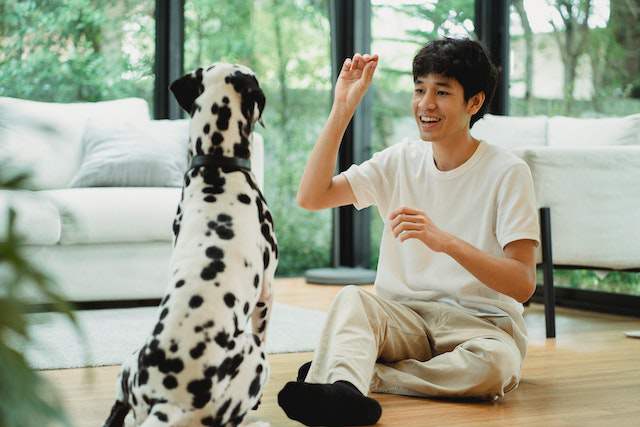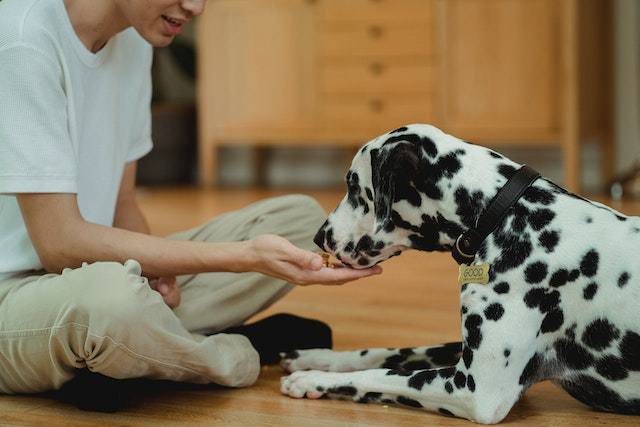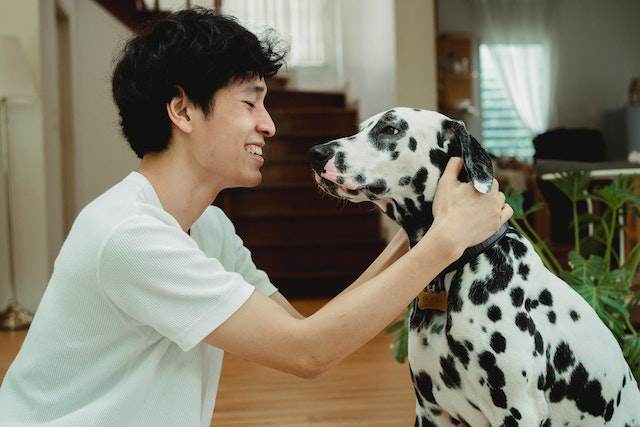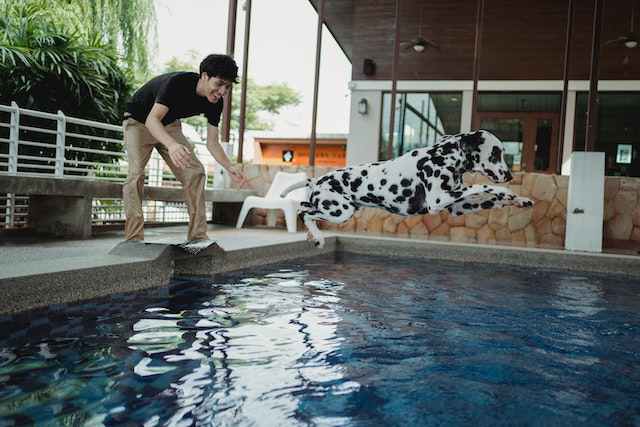Dog Positive Reinforcement Training Tips

Let’s discuss dog positive reinforcement training…
Are you tired of your furry friend’s mischievous behavior? Perhaps you’re looking for an effective and humane way to train your dog without using punishment or force. Well, look no further because today we’re talking about dog positive reinforcement training!
This is an approach that focuses on rewarding desired behavior and using positive reinforcement to encourage your pup to repeat those behaviors.
In this post, we’ll dive deep into the world of positive reinforcement training and explore how it can benefit both you and your furry friend.
What is Dog Positive Reinforcement Training?
Dog positive reinforcement training is a method of training dogs that focuses on rewarding good behavior with positive reinforcement, such as treats and praise, instead of punishing bad behavior. This method helps create a positive association between the dog and the training, making it more enjoyable and effective.
Benefits of Dog Positive Reinforcement Training

Here are some benefits of positive reinforcement training for dogs:
- Increases obedience: Positive reinforcement training can help dogs learn obedience, which can make them easier to handle and keep safe.
- Reduces behavioral problems: Positive reinforcement training is associated with a reduction in behavioral problems in dogs, such as aggression, chewing, and digging.
- Builds self-esteem: Positive reinforcement training helps build a dog’s self-confidence and self-esteem, which can lead to better behavior.
- Strengthens the bond between dog and owner: Positive reinforcement training can help strengthen the bond between dogs and their owners, which can lead to a stronger, more fulfilling relationship.
- Encourages good habits: Positive reinforcement training encourages dogs to engage in good habits, such as going to the bathroom in the appropriate spot and not jumping on people.
- Improves communication: Positive reinforcement training helps dogs learn to communicate with their owners, which can improve their overall behavior.
- Reduces stress: Positive reinforcement training can help reduce stress in dogs, which can lead to better physical and mental health.
- Increases overall happiness: Positive reinforcement training can lead to overall happiness in dogs, as they enjoy the rewards and attention associated with good behavior.
- Safe and humane: Positive reinforcement training methods are considered safe and humane, as they rely on rewards and praise rather than punishment and physical force.
Basic Principles of Dog Positive Reinforcement Training
Positive reinforcement training is a method of dog training that uses rewards to encourage and reinforce desired behaviors. The use of positive reinforcement has been shown to be more effective than punishment-based methods that use physical force and intimidation. The basic principles of dog positive reinforcement training are discussed below:
A. Rewards and Treats
One of the most important principles of positive reinforcement training is the use of rewards and treats. When a dog performs a desired behavior, they are immediately rewarded with a treat, which reinforces the behavior and encourages them to repeat it in the future. Treats should be something that the dog is highly motivated by, such as small pieces of chicken or cheese.
B. Timing and Consistency
Correct timing and consistency are essential when using positive reinforcement. The reward should occur immediately after the desired behavior is performed. If there is a delay between the behavior and the reward, the dog may not make the connection between the two. Consistency is also important, as the dog needs to learn that the behavior will always be rewarded.
C. Clicker Training
Clicker training is a form of positive reinforcement training that involves using a clicker to mark the desired behavior, followed by a treat. The clicker is a small device that makes a distinct clicking sound when pressed. The sound of the click is paired with the reward so that the dog learns to associate the sound with the positive outcome.
D. Verbal Praise and Affection
In addition to treats and clicker training, verbal praise and affection are also important components of positive reinforcement training. When a dog performs a desired behavior, the owner should immediately praise them with a cheerful tone of voice and a pat on the head. This helps to reinforce the behavior and strengthen the bond between the dog and their owner.
Learn more about dog training mistakes you should avoid.
Things to Keep in Mind Before Dog Positive Reinforcement Training
Here are some things to keep in mind before dog positive reinforcement training:
A. Establishing a positive association with the training process
The first step in positive reinforcement training is to establish a positive association with the training process. This can be done by creating a relaxed and positive environment in which training sessions are conducted. Treats, praise, and toys can be used to create positive associations and to reinforce desired behaviors.
B. Setting clear and achievable goals
The next step is to set clear, specific, and achievable training goals. This allows for a focused training approach and helps to ensure that progress is made in a timely manner.
C. Teaching basic commands using positive reinforcement
Training should begin with basic commands such as “sit,” “stay,” and “come.” These commands can be taught through a process of positive reinforcement. When the dog performs the desired behavior, a reward is given, such as a treat or praise. This helps to reinforce the desired behavior and strengthen the dog’s understanding of the command.
For example, to teach “sit,” the dog is lured into a sitting position with a treat, and then rewarded with the treat. This process is repeated until the dog learns to sit on command.
Examples of problem-solving using dog positive reinforcement

Positive reinforcement training can also be used to address dog problem behaviors. Here are a few examples:
Chewing and Biting
Dogs like to chew and bite, but this can become a problem when they destroy furniture or become aggressive. To fix this problem with positive reinforcement:
- Provide your dog with appropriate toys to chew on.
- Reward your dog with praise or treats when they chew on their toys instead of furniture or hands.
- Set up training sessions to teach your dog what they should and shouldn’t chew on.
Fear and Anxiety
Fear and anxiety can cause a wide range of behavior problems in dogs, including aggression and destructive behavior. To address these issues using positive reinforcement:
- Create a safe and stress-free environment for your dog.
- Use positive reinforcement to reward your dog’s calm behavior.
- Gradually expose your dog to the source of their fear while using rewards to encourage them to remain calm.
Poor Recall
Dogs with poor recall won’t come back when called, which can be dangerous. To address this issue using positive reinforcement:
- Use rewards and praise to encourage your dog to come back when called.
- Train your dog to come back on command using positive reinforcement.
- Train your dog using a long leash to give them the freedom to move while keeping them close enough to call back easily.
Dealing with Nippy Dogs
Nipping is a behavior problem that dogs venture into while playing or due to fear and aggression. To fix this problem with positive reinforcement:
- Stop playing if your dog nips.
- Use positive reinforcement to encourage your dog to use items like toys instead of hands and feet.
- Seek professional help if the problem persists.
Pulling on the Leash
Dogs who pull on the leash can be a challenge to walk and can get away from their owners. To fix this problem with positive reinforcement:
- Use a front-clip harness or head collar to ensure that your dog doesn’t pull.
- Reward your dog’s good behavior, such as walking calmly beside you.
- Use treats or praise to redirect your dog’s attention back to you if they start to pull.
Jumping on People
Jumping on people can be a frustrating behavior problem. To address this problem using positive reinforcement, try the following:
- Teach your dog a “sit” command.
- Reward your dog with treats and positive reinforcement when they sit instead of jumping.
- Teach your visitors to reward your dog with positive reinforcement when they sit instead of jumping.
Aggression
Aggression is a serious dog behavior problem that can lead to injuries and legal issues. To address this problem using positive reinforcement, try the following:
- Teaching your dog alternative behaviors such as sitting and looking away when in situations that trigger aggression.
- Use positive reinforcement to reward your dog when they are calm around people or other dogs.
- Teach your dog basic obedience commands, like “sit” and “stay.”
- Reward your dog with treats, praise, or toys when they display the desired behavior.
Separation Anxiety
Separation anxiety is a common dog behavior problem that can lead to destructive behavior, bathroom accidents, and excessive barking or howling. To address this problem using positive reinforcement, try the following:
- Get your dog used to being alone gradually.
- Provide your dog with toys and other objects to keep them occupied while you’re gone.
- Provide your dog with positive reinforcement when they behave calmly while you’re away.
Excessive Barking
Dogs bark for many reasons, but excessive barking can be a problem that interferes with your life and disturbs your neighbors. To address this problem using positive reinforcement, try the following:
- Teach your dog a quiet command.
- Reward your dog for barking less or stopping barking on command.
- Ensure that your dog gets enough exercise and attention.
Remember to be consistent with your training and seek professional help if needed.
Troubleshooting in Dog Positive Reinforcement Training

Positive reinforcement training is a technique used to train dogs by rewarding desired behaviors. While the method is generally effective, there can be certain challenges that need to be addressed when using positive reinforcement training for dogs.
Here’s what you need to know:
A. Common challenges in dog positive reinforcement training:
- Inconsistent reinforcement: If the dog is not consistently rewarded for the desired behavior, it can become confused and not understand what it is meant to do.
- Distractions: Dogs can get easily distracted during training, which can affect their focus. Distractions can be in the form of other people, animals, or even random objects.
- Lack of patience: Positive reinforcement training requires patience and consistency, and if the trainer is not patient, the dog may become frustrated and lose interest.
- Fear and anxiety: Some dogs may be fearful or anxious during training, which can affect their ability to learn and respond to positive reinforcement.
B. How to address setbacks and difficulties during dog positive reinforcement training:
- Go back to basics: If the dog is not responding to a specific behavior, it’s important to go back to the basics and reinforce the behavior that the dog already knows.
- Increase rewards: If the dog is not responding to the rewards offered, try increasing the value of the reward to something that the dog finds more valuable.
- Eliminate distractions: If distractions are causing the dog to lose focus, try training in a quieter and more controlled environment until the dog is better able to focus.
- Take a break: If the dog is becoming frustrated or stressed, it’s important to take a break from training and resume when the dog is more relaxed and focused.
C. Adjusting training methods based on individual dog’s personality and needs during dog positive reinforcement training:
- Different dogs have different personalities, and it’s important to adjust training methods based on each individual dog’s personality, learning style, and needs.
- Dogs that are timid or shy may need a slower and gentler approach, while more energetic dogs may need more frequent and intense training sessions.
- Dogs that are easily distracted may need shorter and more frequent training sessions, while dogs that are more focused may be able to handle longer training sessions.
- If a particular behavior is not working for a dog, it’s important to adjust the training method and try different strategies until the desired behavior is achieved.
Choosing the Right Rewards

Rewards play a vital role in positive reinforcement training. It’s important to choose rewards that are highly motivating for your dog.
These can include treats, verbal praise, petting, playtime, or a combination of these. Experiment with different rewards to find out what your dog finds most enticing and effective.
Related Questions
Is Positive Reinforcement Training Suitable for all dogs?
Yes, Positive Reinforcement Training is suitable for all dogs, regardless of breed, age, or temperament. This method of training is based on teaching and rewarding desirable behavior rather than punishing bad behavior, which can be stressful to the dog and the owner.
Will my dog only respond to Positive Reinforcement Training if there are treats involved?
Initially, treats are necessary to establish the new behavior. Once the dog associates the treat with the new behavior, the treat can be gradually substituted with praise. Dogs naturally crave their owner’s attention and affection, which can become a more effective reinforcer as the training progresses.
Should I hire a professional to guide me through Positive Reinforcement Training?
It may be useful to consult a professional trainer or attend a positive reinforcement training class to learn more about the methods and techniques involved. Professional guidance can also be useful if your dog is displaying behavior issues that are difficult to handle. However, Positive Reinforcement Training can also be learned and implemented with success by pet owners with some background knowledge of dog behavior and training.
Learn more about training your dog not to run away.
Conclusion
In conclusion, dog positive reinforcement training can bring out the best in your furry friend. By rewarding good behavior, you build a stronger bond with your pup and create a positive living environment.
So, don’t hesitate to grab your treat bag and start training! Your pup will thank you for it. Remember, with patience, love, and positive reinforcement, your dog can become the well-behaved, happy, and loyal companion you’ve always dreamed of.
